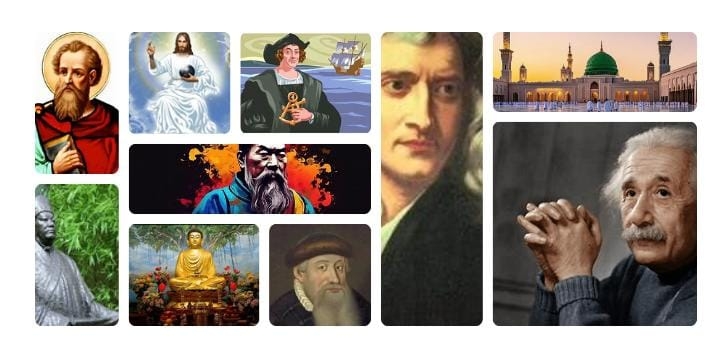
Top 10 Most Influential Persons of All Times History
This list of top 10 most influential persons of history ever is taken from the list of 100 most influential people in the world chosen by Michael H. Hart, from the book ‘100 most influential people in the world’. He chose people on a ranking of who had done the most to influence the world.
- Muhammad (570 – 632 AD) Prophet of Islam.
- Isaac Newton (1642 – 1727) – British mathematician and scientist.
- Jesus of Nazareth (c.5BC – 30 AD) Spiritual teacher and central figure of Christianity.
- Buddha (c 563 – 483 BC) Spiritual Teacher and founder of Buddhism.
- Confucius (551 – 479 BC) – Chinese philosopher.
- St. Paul (5 – AD 67) – Christian missionary and one of the main writers of the New Testament.
- Ts’ai Lun (AD 50 – 121) Inventor of paper.
- Johann Gutenberg (1395 – 1468) – Inventor of the printing press.
- Christopher Columbus (1451 – 1506) – Italian explorer landed in America.
- Albert Einstein (1879 – 1955) German/ US scientist discovered Theory of Relativity
Muhammad: Life and Legacy

Muhammad, born around 570 CE in Mecca (now part of Saudi Arabia) and passing away on June 8, 632 CE in Medina, was the founder of Islam and the messenger of the Qurʾān. He is traditionally believed to have been born in Mecca and died in Medina, where he and his followers moved in 622 CE after facing persecution.
The Qurʾān, which contains limited direct biographical details about Muhammad, refers to him as a “messenger of God” in several verses (e.g., 3:144). It mentions locations related to his life, such as the Kaʿbah in Mecca and a town called al-madīnah or Yathrib (e.g., 33:13, 60). However, it provides no specific dates or detailed accounts of events. The text often alludes to conflicts and battles but lacks precise historical details and names of contemporaries, making it insufficient for a detailed biography.
Most of the detailed biographical information about Muhammad comes from sources outside the Qurʾān, primarily from the sīrah (biography) literature. The most significant early work in this genre is Muḥammad ibn Isḥāq’s Kitāb al-maghāzī (“Book of [the Prophet’s] Military Expeditions”), which survives only through later revisions, notably ʿAbd al-Malik ibn Hishām’s Sīrat Muḥammad rasūl Allāh (“Life of Muhammad, the Messenger of God”). Ibn Isḥāq’s original work was a compilation of various reports about Muhammad’s life, arranged chronologically and supplemented with his own comments. These reports often trace back to eyewitnesses, like the Prophet’s wife ʿĀʾishah.
The biographical narratives in the sīrah literature, dating from the 8th or 9th century, raise questions about their historical accuracy. Although they may not have been deliberately fabricated, some stories might have been influenced by popular legends. Additionally, some accounts might reflect biblical themes, such as parallels between Muhammad’s life and the lives of earlier prophets like Moses and Jesus. For example, before Muhammad’s migration to Medina, he is said to have received an oath of allegiance from twelve men, similar to the Twelve Apostles, and his miraculous feeding of workers during the digging of a trench around Medina mirrors Jesus’ feeding of the multitude. It is also possible that some reports were based on interpretations of Qurʾānic verses rather than actual historical events.
Scholars have found that some traditions about Muhammad’s life, such as his migration from Mecca to Medina, were already circulating by the late 7th century. Notable early collectors of these traditions include ʿUrwah ibn al-Zubayr, who likely had direct access to Muhammad’s companions. Non-Islamic sources from the early decades after Muhammad’s death also support the existence of an Arab prophet named Muhammad. For instance, a Syriac chronicle from around 640 CE and an Armenian history from about 660 CE describe Muhammad and his role in the early Islamic conquests. However, some non-Islamic sources suggest discrepancies with the Islamic narrative, such as Muhammad still being alive during the Arab conquest of Palestine (634–640 CE), contrary to the Islamic view that he had already died.
Overall, while there is no strong reason to dismiss the core elements of Muhammad’s traditional biography, the sources do not provide as detailed or certain a historical account as some earlier scholars believed. Many chronological details appear to have been developed by later transmitters rather than being based on early Islamic traditions. Consequently, specific dates and events, such as a battle on March 21, 625 CE, are problematic. The following summary will present a concise overview of Ibn Isḥāq’s account of Muhammad’s life, including both historical facts and later legends, without attempting to remove supernatural elements.
(i) Biography According to Islamic Tradition
Muhammad was born into the Quraysh tribe and the Hāshim clan in Mecca, home to the Kaʿbah, an ancient pilgrimage site founded by Abraham. Over time, worship at the Kaʿbah became dominated by polytheism. Muhammad’s birth in 570 CE is preceded by a dramatic event: his grandfather ʿAbd al-Muṭṭalib nearly fulfills a vow to sacrifice his beloved son and Muhammad’s father, ʿAbd Allāh, resembling the biblical story of Isaac’s near-sacrifice (Genesis 22). Muhammad’s father died before his birth, leaving him under the care of his grandfather ʿAbd al-Muṭṭalib, who died when Muhammad was eight. Muhammad’s uncle, Abū Ṭālib, then took responsibility for him. During a trading journey to Syria with his uncle, Muhammad was recognized as a future prophet by a Christian monk.
At 25, Muhammad began working for Khadījah, a wealthy widow. Impressed by his honesty, Khadījah proposed marriage. Despite being around 40 years old, Khadījah bore Muhammad at least two sons who died young and four daughters, including Fāṭimah, who later married Muhammad’s cousin ʿAlī. Muhammad did not marry another woman while Khadījah was alive, even though polygamy was common at the time.
Muhammad’s prophetic mission began at 40. While retreating in a mountain near Mecca, he experienced a profound encounter with the angel Gabriel, who revealed the opening verses of sūrah 96 of the Qurʾān: “Recite in the name of your Lord who creates, / creates man from a clot! / Recite for your lord is most generous….” Muhammad was initially disturbed by this revelation but was comforted by Khadījah and her cousin Waraqah ibn Nawfal, a learned Christian. Muhammad continued receiving revelations privately for three years until he was commanded to preach publicly. Initially met with little opposition, Muhammad’s public teachings soon clashed with Meccan beliefs, leading to increased hostility. Some followers fled to Ethiopia for safety, and Muhammad’s clan faced social and economic boycotts from other Meccan clans.
One significant event during this period was the Night Journey, where Muhammad is said to have been miraculously transported to Jerusalem and then ascended to heaven, where he received the command for the five daily prayers.
In 619 CE, Muhammad faced personal losses with the deaths of Khadījah and his uncle Abū Ṭālib. The new clan leader, Abū Lahab, withdrew protection from Muhammad, making him vulnerable in Mecca. After failing to secure support in Al-Ṭāʾif, Muhammad gained protection from leaders in Yathrib (later Medina). This allowed him and his followers to migrate to Medina, which was partially inhabited by Jewish tribes. Muhammad, accompanied by Abū Bakr, narrowly escaped an assassination plot due to a warning from Gabriel.
In Medina, Muhammad built a house that served as both a residence and a prayer space. He established a covenant uniting the Muslims of Mecca and Medina, as well as some Jewish tribes, into a single community recognizing him as the “Messenger of God.” Relations with Medina’s Jewish tribes deteriorated over time, especially after a revelation directed Muslims to face Mecca during prayers instead of Jerusalem. The Muslims also began raiding Meccan caravans. Despite a surprising victory at the Battle of Badr in 624 CE, further Meccan attempts to capture Medina in the Battles of Uḥud (625 CE) and the Trench (627 CE) failed. Following these conflicts, Muhammad’s followers expelled the Jewish tribes of Medina, with the last tribe, the Qurayẓah, facing severe consequences.
In 628 CE, Muhammad attempted to perform the pilgrimage to Mecca but was halted by the Meccans at Al-Ḥudaybiyyah. A treaty allowed Muslims to make the pilgrimage in 629 CE. Two months later, Muhammad led a campaign against the Jewish oasis of Khaybar, which eventually submitted. The following year, Muhammad fulfilled the pilgrimage as per the treaty, but a breach by Meccan allies led him to denounce the treaty. In 630 CE, Muhammad led a large army to Mecca, which surrendered, and he declared an amnesty.
Upon returning to Medina, Muhammad received pledges of allegiance from various Arabian tribes. He also led a campaign to the Syrian border and reached Tabūk, securing the submission of several towns. Muhammad personally led the pilgrimage to Mecca in 632 CE, known as the Farewell Pilgrimage. He died in Medina in June 632 CE. The lack of a clear succession plan led to a major dispute over the leadership of the nascent Muslim community.
(ii) Muhammad’s Status in the Qurʾān and Post-Qurʾānic Islam
Muhammad holds a central place in Islamic thought and practice, and his status in post-Qurʾānic Islam often surpasses his depiction in the Qurʾān. The Qurʾān portrays Muhammad as a mortal prophet, akin to previous messengers (e.g., 14:11, 17:93). In contrast, later Sufi thought, such as that of Sahl al-Tustarī (died 896), views him as an incarnation of a divine light, the “Muhammadan light” (al-nūr al-Muḥammadī). The Qurʾān also instructs Muhammad to seek forgiveness for his sins (40:55, 47:19, 48:2) and criticizes him for overlooking a blind man in favor of someone more self-sufficient (80:1–10). However, later Islamic tradition developed the belief that Muhammad, like other prophets, was sinless and that he epitomized “the perfect human being” (al-insān al
Sir Isaac Newton

Overview
Sir Isaac Newton (January 4, 1643 – March 31, 1727) was a pivotal figure in physics, mathematics, and astronomy. He held the esteemed position of Lucasian Professor of Mathematics at the University of Cambridge, a role later held by Stephen Hawking. Newton’s work laid the groundwork for many scientific principles still used today.
Quick Facts: Sir Isaac Newton
- Notable For: Formulating laws of motion and gravity
- Birth: January 4, 1643, in Lincolnshire, England
- Parents: Isaac Newton and Hannah Ayscough
- Death: March 20, 1727, in Middlesex, England
- Education: Trinity College, Cambridge (B.A., 1665)
- Major Works: Principia Mathematica (1687), Opticks (1704)
- Awards: Fellowship of the Royal Society (1672), Knight Bachelor (1705)
- Famous Quote: “If I have seen further than others, it is by standing upon the shoulders of giants.”
Early Life and Influences
Born shortly after his father’s death, Newton was raised by his grandmother after his mother remarried. Disinterested in farming, he pursued studies at Cambridge. Influenced by Galileo’s discoveries, Newton believed the universe functioned like a machine governed by mathematical laws.
Laws of Motion
Newton’s Principia Mathematica (1687) introduced three fundamental laws of motion:
- First Law: An object remains at rest or continues in a straight line unless acted upon by a force (inertia).
- Second Law: An object accelerates in the direction of an applied force.
- Third Law: For every action, there is an equal and opposite reaction.
He also proposed the theory of gravity, showing that planets orbit the sun in elliptical paths due to gravitational forces.
Gravity and Its Significance
Newton’s observations about gravity, famously illustrated by an apple falling from a tree, led him to understand gravity as an attractive force between objects. He extended this concept to explain the Moon’s orbit around Earth, proving that gravity acts over great distances.
Later Life and Conflicts
Newton became warden of the Royal Mint in 1696 and had notable disputes with scientists like Robert Hooke and Gottfried Leibniz. His works, including Optics and Method of Fluxions, were published amidst these conflicts. Newton passed away in 1727 and was buried in Westminster Abbey.
Legacy
Newton’s laws and theory of gravity transformed the understanding of the universe. He demonstrated that the sun’s gravity keeps planets in orbit and that gravitational force depends on distance and mass, marking a significant advancement in science.
Jesus Christ

Overview
Jesus Christ (circa 4 B.C. – A.D. 33) is the central figure of Christianity and its founder. A Jewish carpenter from Nazareth, his life and teachings are recorded in the New Testament’s four Gospels. He is known for his miracles and teachings.
Who Is Jesus Christ?
- Also Known As: Jesus of Nazareth, the Christ, the Messiah, Immanuel (“God with us”)
- Notable For: Being the incarnate Word of God, fully human and divine, and Savior. He chose twelve disciples and sacrificed his life to redeem humanity’s sins.
- Bible Mentions: Over 1,200 times in the New Testament; detailed in Matthew, Mark, Luke, and John.
- Occupation: Likely worked as a carpenter with his father Joseph.
- Hometown: Born in Bethlehem, raised in Nazareth.
Life and Crucifixion
Jesus was crucified in Jerusalem by Pontius Pilate for claiming kingship. He resurrected on the third day, appeared to his disciples, and ascended to heaven. His sacrifice is believed to have reconciled humanity with God, providing a path to eternal life.
Accomplishments
Jesus performed miracles, including turning water into wine, healing the sick, feeding thousands, and raising the dead. His teachings focused on the Kingdom of God and salvation. His crucifixion and resurrection provided redemption and eternal life for believers.
Family Tree
- Heavenly Father: God the Father
- Earthly Father: Joseph
- Mother: Mary
- Brothers: James, Joseph, Judas, Simon
- Sisters: Mentioned but not named
- Genealogy: In Matthew 1:1-17 and Luke 3:23-37.
Life Lessons
Jesus’ teachings cover love, sacrifice, humility, and devotion, which are central to Christian faith.
Buddha (Siddhartha Gautama)
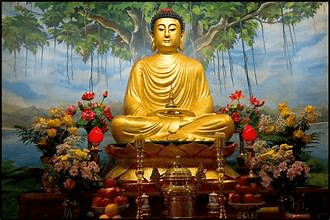
Overview
Siddhartha Gautama, known as Buddha, lived around the 6th to 4th century BCE. Born a prince in what is now India-Nepal, he led a life of luxury until he encountered human suffering, prompting him to seek enlightenment.
Journey to Enlightenment
Renouncing his royal life, Siddhartha practiced asceticism but found it insufficient. He meditated under the bodhi tree, achieving enlightenment by understanding the Four Noble Truths and the Eightfold Path. His first sermon at Sarnath outlined these teachings.
Buddhism
Founded by Siddhartha, Buddhism aims to end suffering and escape the cycle of rebirth, seeking nirvana. It emphasizes meditation and ethical conduct, rejecting Hindu deities while adopting some Hindu concepts like karma. Buddhism spread across Asia, reaching Sri Lanka, Southeast Asia, China, Korea, and Japan, and gained Western followers in the 19th and 20th centuries.
Major Teachings
Buddhism’s core teachings are the Four Noble Truths and the Eightfold Path, with major branches including Mahayana and Theravada. By the early 21st century, Buddhism had over 375 million followers worldwide.
Confucius: Life and Legacy
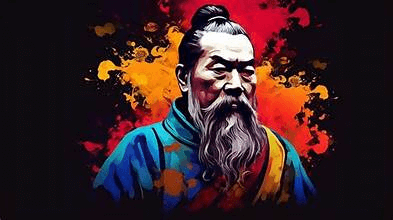
Confucius, born in 551 BCE in Qufu (now Shandong province, China), was a prominent teacher and philosopher whose ideas influenced China and East Asia.
Early Life
Confucius was born towards the end of the Spring and Autumn Period (770–481 BCE) in Lu, a state in eastern China. Lu had ties to the Zhou dynasty (1045–221 BCE) through history and family connections. Confucius’s ancestors, the Kongs, were once influential in the state of Song but had lost their status and moved to Lu. Confucius’s father, Shu-liang He, was a district steward in Lu and had other children from a previous marriage. After his death, Confucius’s mother had to support him alone.
Career and Challenges
Confucius acknowledged that his modest background made it harder to enter government service compared to those from wealthy families. He began working with the Jisun clan, eventually rising to significant roles like minister of works and minister of crime. His effectiveness in handling legal and diplomatic matters was notable, but his career ended due to conflicts with powerful hereditary families in 498 BCE. This forced him into exile.
Exile and Journey
Confucius spent 14 years traveling through Wei, Song, Chen, and Cai, seeking rulers who would adopt his ideas on virtuous governance. Despite his efforts, he found no ruler willing to fully embrace his vision. He faced dangers, including ambushes and hostile mobs, but remained determined and hopeful about his mission.
Return and Later Life
After his travels, Confucius returned to Wei, where he was later welcomed back to Lu through the efforts of his disciples Zigong and Ran Qiu. He was respected as a “state’s elder” and provided advice without seeking official office. His teachings attracted many, including those interested in moral philosophy and practical skills.
Confucius’s approach to teaching was to guide students to find their own answers, emphasizing moral integrity and competence. He continued to teach and reflect until his death at 73 in 479 BCE. His legacy endures, as his ideas on character and governance continue to influence China and beyond.
St. Paul the Apostle: Life and Mission
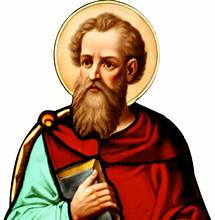
St. Paul the Apostle, born around 4 BCE in Tarsus, Cilicia (modern-day Turkey), and died circa 62–64 CE in Rome, was a pivotal leader in early Christianity, considered the most significant figure after Jesus. Despite his prominence in the early Christian community, Paul faced considerable opposition and was not as respected as Peter and James during his time. However, his letters have greatly influenced Christianity and established him as one of the greatest religious leaders in history.
Early Life and Background
Paul was a Greek-speaking Jew from Asia Minor. Tarsus, his birthplace, was an important city in eastern Cilicia, later part of the Roman province of Syria. Damascus and Antioch, major cities in Syria, were central to his missionary work. Although his exact birth date is unknown, his active missionary work in the 40s and 50s CE suggests he was born around the same time as Jesus or slightly later. Paul converted to Christianity around 33 CE and died, likely in Rome, around 62–64 CE.
As a child, Paul learned to “work with [his] own hands” (1 Corinthians 4:12) and continued his trade of tent making after his conversion. This trade allowed him to travel and work with minimal equipment. His family was likely not wealthy, and his use of Koine Greek in his letters rather than refined literary Greek suggests he was not an aristocrat. Paul could dictate and write in large letters (Galatians 6:11) but not in the neat script of professional scribes.
Pharisaic Background
Paul was a Pharisee for much of his life. The Pharisees, a Jewish sect that emerged in the later Second Temple period, believed in life after death and valued oral traditions alongside the written Bible. Paul shared these beliefs and was knowledgeable about both the Hebrew Bible and its Greek translation. He considered himself the best Pharisee of his generation (Philippians 3:4–6; Galatians 1:13–14) but saw his successes as due to God’s grace rather than his own merit.
Persecution and Conversion
Paul initially persecuted early Christians, though his reasons are unclear and seem unrelated to his Pharisaic beliefs. The main persecutors in Jerusalem were likely Sadducees, while the Pharisee Gamaliel defended Christians (Acts 5:34). Paul may have been troubled by Jewish converts not strictly following the law or associating with Gentiles. He probably rejected the idea of Jesus being raised from the dead due to the belief that such an event should happen only at the world’s final judgment.
Paul’s persecution likely involved traveling from synagogue to synagogue, advocating for punishment of Jews who accepted Jesus. He faced punishments himself (2 Corinthians 11:24) and claimed that he did not know the Jerusalem Christians until after his conversion (Galatians 1:4–17), despite Acts suggesting otherwise.
Mission and Influence
Paul believed his vision confirmed Jesus was the Messiah and would return soon. He saw his mission as preaching to the Gentiles (Galatians 1:16) and hoped to make his own people envious, thereby saving some of them (Romans 11:13–14). Paul’s view reversed traditional beliefs by prioritizing the Gentile mission before the conversion of Jews. His method of converting Gentiles is unclear, but he may have used his trade to engage people and spread his message effectively.
Cai Lun: The Inventor of Paper
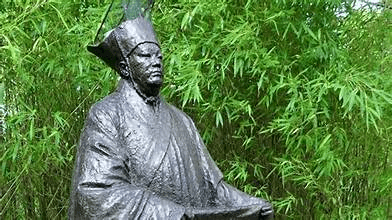
Cai Lun (born around 62 CE in Guiyang, now Leiyang in Hunan province, China, and died in 121 CE) was a Chinese court official renowned for inventing paper. Cai Lun, a eunuch, began his service at the imperial palace in 75 CE. By 89 CE, he had risen to the position of chief eunuch under Emperor Hedi of the Eastern Han dynasty.
Around 105 CE, Cai Lun introduced a revolutionary method for making paper. He created sheets from a mixture of tree bark, hemp waste, old rags, and fishnets. This new paper was superior to the silk cloth used previously for writing, offering better quality at a lower cost and using more readily available materials. Cai Lun presented his invention to the emperor, who praised him for this innovation. Cai Lun’s apprentice, Zuo Bo, later improved the papermaking process, leading to its widespread adoption throughout China and eventually the world. Cai Lun was honored with the title of marquess in 114 CE.
Johannes Gutenberg: Pioneer of Printing

Johannes Gutenberg (born in Mainz, Germany, in the 14th century and died around February 3, 1468, in Mainz) was a German inventor known for developing a printing method using movable type. His invention included a special metal alloy for durable type, an oil-based ink for clear printing, and a press adapted from those used in wine or paper production. This technology was a significant advancement over earlier methods like woodblock printing and stamping.
For a long time, Gutenberg was believed to have invented the punch-matrix system of casting metal type, where a punch created impressions on a matrix to form reusable type. However, computer analysis of Gutenberg’s prints in the early 2000s revealed too much variation for this method to be accurate. Scholars now think that the punch-matrix system likely emerged after Gutenberg’s death.
Gutenberg, born to a patrician family in Mainz, acquired skills in metalwork. His involvement in printing started around 1434 in Strasbourg, France, where he worked in various crafts and taught students. In 1438, he signed a five-year contract with partners Hans Riffe, Andreas Dritzehn, and Andreas Heilmann. The contract included terms for handling partners’ deaths and their heirs.
When Dritzehn died in 1438, his heirs attempted to claim partnership rights, but they lost the lawsuit. The trial revealed Gutenberg’s secret project: the invention of a printing press. Despite facing financial challenges and disputes with his financier Johann Fust, Gutenberg continued to refine his printing technology.
By 1450, Gutenberg had secured an investment of 800 guilders from Fust, who later invested another 800 guilders for a partnership. Tensions between Fust and Gutenberg over financial matters led to a legal battle in 1455, resulting in Gutenberg being ordered to repay Fust. Contrary to earlier beliefs that this ruined Gutenberg, recent research suggests it allowed him to continue his printing business through the 1450s and possibly into the 1460s.
Christopher Columbus: The Explorer’s Legacy
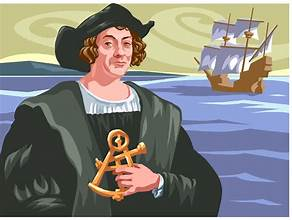
Christopher Columbus, an Italian explorer born in Genoa, Italy, in 1451, is known for his voyages across the Atlantic Ocean, which began in 1492. Though he aimed to find a direct route to Asia, Columbus instead encountered the Americas. While he did not “discover” the New World, as it was already inhabited, his expeditions initiated centuries of exploration and colonization in North and South America.
Columbus’s early maritime experience began in his teenage years. After a shipwreck in 1476, he studied navigation and began planning his significant journey. His proposal to sail west across the Atlantic was based on the incorrect assumption that the Earth’s circumference was smaller than previously believed. In 1492, he convinced Spanish monarchs Ferdinand and Isabella to sponsor his voyage.
On August 3, 1492, Columbus set sail with three ships: the Niña, the Pinta, and the Santa Maria. He landed in the Bahamas on October 12, 1492, mistakenly believing he had reached the East Indies. Columbus spent months exploring the Caribbean, searching for valuable resources but found little. He returned to Spain in January 1493 with only a few men left behind.
Columbus’s subsequent voyages included returning to the Americas in September 1493, where he found the initial settlement on Hispaniola destroyed. He attempted to continue his search for wealth but faced numerous challenges, including the revolt of colonists and the harsh treatment of indigenous people. Columbus was eventually arrested and returned to Spain in chains in 1500. In 1502, despite being stripped of his titles, he secured funding for one last voyage, reaching Panama before returning to Spain in 1504, where he died in 1506.
Columbus’s voyages did not “discover” the Americas, as Viking explorer Leif Erikson had reached parts of the New World in the 11th century. However, Columbus’s expeditions marked the beginning of extensive exploration and colonization. His journeys initiated the Columbian Exchange, which introduced new foods, animals, and diseases between the Old and New Worlds. Today, Columbus is remembered as a pioneering explorer whose actions had profound and often devastating effects on native populations.
Albert Einstein: The Legacy of a Genius

Albert Einstein: The Legacy of a Genius
Albert Einstein, born March 14, 1879, in Ulm, Germany, and passing away April 18, 1955, in Princeton, New Jersey, was a German-born physicist famed for his theories of special and general relativity. He won the Nobel Prize for Physics in 1921 for his explanation of the photoelectric effect and is regarded as one of the most influential scientists of the 20th century.
Early Life and Education
Einstein came from a secular, middle-class Jewish family. His father, Hermann, initially sold featherbeds and later managed a moderately successful electrochemical factory, while his mother, Pauline, handled the household. Einstein had a younger sister, Maja.
Two early experiences deeply impacted Einstein. At age five, he was fascinated by a compass, which sparked his interest in unseen forces. At twelve, he found a geometry book that he called his “sacred little geometry book.” His early religious fervor faded as he encountered scientific ideas that conflicted with his beliefs, causing him to question established authority. At school, he felt stifled by the rigid Prussian educational system and was told he would never achieve much.
Max Talmud (later Talmey), a medical student who frequently visited the Einstein home, became a mentor, introducing Einstein to advanced mathematics and philosophy. This guidance led Einstein to ponder what a light beam would look like if you could run alongside it, eventually leading to his development of the theory of relativity. He also wrote his first scientific paper on “The Investigation of the State of Aether in Magnetic Fields.”
Education and Early Career
Einstein’s education faced setbacks due to his father’s business failures. In 1894, after a business loss, Hermann moved to Milan, leaving Albert behind in Munich. Disheartened, Einstein ran away and returned to his parents. His parents, concerned about his future, supported him in applying directly to the Swiss Federal Polytechnic School in Zürich, despite his academic struggles in some subjects. Einstein completed his schooling in Aarau, Switzerland, graduated in 1896, and renounced his German citizenship, becoming stateless until he received Swiss citizenship in 1901.
In Zürich, Einstein made lasting friendships, including with Marcel Grossmann and Michele Besso, and met Mileva Maric, his future wife.
Breakthroughs and Recognition
After graduating in 1900, Einstein faced significant challenges. His independent study habits led to rejections for academic positions, exacerbated by strained relations with professors like Heinrich Weber. Despite these setbacks, Einstein deepened his relationship with Maric, and they had a child, Lieserl, whose fate is uncertain.
Desperate for work, Einstein took a low-level position at the Swiss patent office in Bern, thanks to a recommendation from Grossmann’s father. With a steady income, he married Maric in 1903, and their children, Hans Albert and Eduard, were born in 1904 and 1910, respectively.
In 1905, Einstein published four pivotal papers in Annalen der Physik, marking his “miracle year”:
- Photoelectric Effect: Explained using quantum theory, introducing photons.
- Brownian Motion: Provided experimental proof of atoms.
- Special Relativity: Introduced the theory of special relativity.
- E = mc²: Showed that energy and mass are interchangeable, explaining stellar energy.
Einstein’s theory of relativity initially received little attention, but Max Planck’s endorsement and subsequent experiments confirmed his theories, elevating his reputation. He held positions at prestigious institutions, including the University of Berlin.
Later Life and Legacy
During World War I, Einstein, a pacifist, criticized nationalism and mediated a university crisis in Berlin. His theory of general relativity was confirmed by observations of light deflection around the Sun in 1919, leading to worldwide acclaim. He was awarded the Nobel Prize in Physics in 1921 for the photoelectric effect.
Einstein continued to influence cosmology, introducing a cosmological constant to stabilize his universe model, which was later proven to be significant in understanding the universe’s fate. His fame led to public appearances and discussions with notable figures like Sigmund Freud and Rabindranath Tagore.
Einstein’s religious views evolved to embrace a pantheistic view of God, focusing on harmony and beauty in the universe. His profound contributions continue to shape our understanding of physics and the cosmos.
Nazi Backlash and Moving to America
Einstein’s growing fame and successful theories led to backlash, especially from the Nazis, who labeled relativity as “Jewish physics.” They organized conferences and book burnings to denounce Einstein and recruited physicists like Philipp Lenard and Johannes Stark to join their campaign. The book One Hundred Authors Against Einstein was published in 1931. Einstein responded that disproving relativity required just one fact, not a hundred scientists.
By December 1932, Einstein realized his life was at risk and decided to leave Germany permanently. A Nazi magazine even published a photo of him with the caption “Not Yet Hanged” and offered a bounty on his head. Given the threats, Einstein shifted his stance on pacifism, arguing that self-defense against Nazi aggression was justifiable. He believed pacifism was not absolute and needed reconsideration in severe situations.
Einstein moved to the newly formed Institute for Advanced Study in Princeton, New Jersey, which quickly became a global center for physics. News outlets compared Princeton to the Vatican, marking it as the new hub of physics.
Personal Struggles, World War II, and the Atomic Bomb
The 1930s were difficult for Einstein. His son Eduard was diagnosed with schizophrenia in 1930 and remained institutionalized for life. His close friend, physicist Paul Ehrenfest, committed suicide in 1933, and Einstein’s wife Elsa passed away in 1936.
In the late 1930s, physicists began to explore whether Einstein’s equation E = mc² could lead to an atomic bomb. Although Einstein had initially dismissed this idea, research by Otto Hahn, Fritz Strassmann, Lise Meitner, and Otto Frisch showed that splitting uranium could release enormous energy. This discovery shocked the physics community.
In July 1939, physicist Leo Szilard convinced Einstein to write a letter to President Franklin D. Roosevelt, urging the development of an atomic bomb. The letter, signed by Einstein and delivered by Roosevelt’s adviser Alexander Sachs on October 11, led to the formation of the Uranium Committee.
Einstein became a U.S. permanent resident in 1935 and an American citizen in 1940, while retaining his Swiss citizenship. Although he was pivotal in initiating the atomic bomb project, he was excluded from participating due to concerns about his pacifist and socialist affiliations. Instead, he contributed by helping the U.S. Navy with future weapon designs and auctioned valuable manuscripts, including his 1905 paper on special relativity, which sold for $6.5 million and is now in the Library of Congress.
After hearing about the atomic bomb’s use on Japan, Einstein joined efforts to regulate nuclear weapons and helped form the Emergency Committee of Atomic Scientists. He opposed the development of the hydrogen bomb and called for international controls on nuclear technology, becoming more involved in antiwar activities and civil rights for African Americans.
In 1952, Israeli Prime Minister David Ben-Gurion offered Einstein the presidency of Israel, but Einstein, a notable Zionist, declined the offer.
Increasing Isolation and Death
Despite continuing to make contributions to general relativity, including theories about wormholes and black holes, Einstein became increasingly isolated from the physics community. Most physicists focused on quantum theory, leading to historic debates between Einstein and Niels Bohr. Einstein’s famous critique of quantum mechanics, the EPR (Einstein-Podolsky-Rosen) thought experiment, argued that quantum theory’s notion of instantaneous communication violated relativity. Subsequent experiments confirmed quantum theory was correct.
Einstein also obsessed over a unified field theory, aiming to integrate all fundamental forces into one framework. In his later years, he tried to incorporate quantum theory into this theory but remained reclusive, preferring long walks and discussions with close friends. An incomplete article on his theory was published in Scientific American in 1950. Einstein died from an aortic aneurysm in 1955, leaving his unified field theory unfinished.
Legacy of Albert Einstein
Einstein’s ideas were ahead of their time. The strong force, crucial to a unified field theory, was not understood during his lifetime but was later explained with the quark model. His work continues to influence modern science. Nobel Prizes have been awarded for discoveries related to his theories, such as gravitational waves in 1993 and Bose-Einstein condensates in 1995. Thousands of black holes have been identified, and space missions continue to validate Einstein’s cosmological predictions. Efforts to complete Einstein’s dream of a “theory of everything” remain ongoing.




